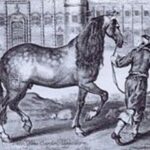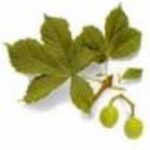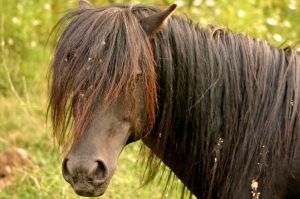The Suffolk Punch is one of the Western world’s best known rare draft horse breeds. Unlike many other draft horse breeds, Suffolk Punches usually come in one color – chestnut – and lack the dramatic leg feathering. By tradition, Suffolk breeders and owners spell the color of their horses “chesnut” because that was how the word was spelled centuries ago.
A resurgence of interest in draft horses may ensure the Suffolk Punch’s survival beyond the Twenty-first century, especially in America, home to about 1000 of these special drafters. England only has about 150, notes the American Suffolk Horse Association.
Brief History
As its name suggests, the Suffolk Punch originated in Suffolk county, England. The “Punch” part of the name is more difficult to explain. Although now the word “punch” is associated with a beverage or an activity in boxing, back in the seventeenth century it referred to a body that was well-rounded (or well-muscular.) The Suffolk Punch used to be called the Old Breed as early as 1586, but changed to a catchier name, the Suffolk Sorrel, before settling on the Suffolk Punch in the 1700s.
Many horse breeds can trace back to a foundation stallion and the Suffolk Punch is no exception. Its foundation stallion was a stallion foaled inn 1760 known to history as Crisp’s Horse of Ufford. Whether the stallion was actually called that to his face is unknown. The Suffolk Horse Society, formed in 1877, is one of the oldest horse breed registries in England.
All seemed well until the two World Wars and the mechanization of agriculture nearly wiped the breed out. Some Belgians were allowed into the registry to save the breed from extinction. Other breeds thought to have gone into the Suffolk at one time or another are the thoroughbred, Fell pony, Dales pony, Haflinger and the now extinct breeds Norfolk Trotter and Norfolk Cob.
General Appearance
This is a massive horse with plenty of pulling power. Unlike many other draft breeds, Suffolk breeders have mostly resisted the trend to produce slimmer animals for the sport horse market. The Suffolk can weigh up to 2100 pounds when fully mature with most of that weight from muscle and not fat. Stallions are usually larger and heavier than mares. Suffolks can grow up to a whopping 17 hands high, but average 15.2 to 16 hands.
Their color is always chestnut, with varying shades. Manes and tails can be the same or lighter than the body color. Socks, stars, snips and blazes are frequent, although conspicuous white markings are frowned upon by traditionalists. Their legs lack the shaggy hair of many other draft breeds because the feathering was too difficult for Suffolk farmers to clean. This is a long lived breed, often working well into their 20s.
Additional References
International Encyclopedia of Horse Breeds. Bonnie Hendricks. University of Oklahoma Press; 1995.
The Encyclopedia of Horses & Ponies. Tasmin Pickeral. Paragon Publishing; 1999.
Storey’s Illustrated Guide to 96 Horse Breeds of North America. Judith Dutson. Storey Publishing; 2005.
The Official Horse Breeds Standard Book. Fran Lynghaug. Voyageur; 2009.





